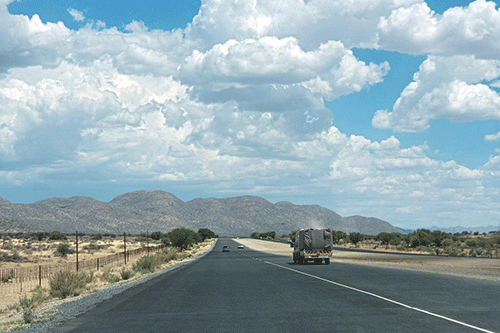The Road Fund Administration (RFA) says revenue collected from current Road User Charges (RUCs) is insufficient for the needs required for sufficient road network maintenance in the country. RFA CEO Ali Ipinge said the result is a 22% funding gap on the allocated maintenance budget of N$4.2 billion for the current financial year 2023/2024.
RUCs were implemented to economically recover the full cost of road expenditure from road users.
The RUCs were designed to ensure that much-needed revenue to provide and maintain roads is raised from road users (including foreign road users), rather than general taxpayers.
The RUCs were also meant to generate funds proportionately from road usage. This was also intended to improve economic efficiency in road transport by removing price distortions and charging road users according to the actual roads’ utilisation.
In a statement released yesterday, Ipinge noted that due to the proliferation of electric and fuel-efficient vehicles over the last 15 years, vehicle fuel demand has fallen on average by 2% per year.
“This trend will continue as the world phases out gasoline and diesel-powered vehicles, which will result in regular funding gaps for maintenance and a systematic deterioration of the road infrastructure. Fuel-powered vehicles and associated fuel demand will eventually phase out, rendering the current road maintenance funding model unsustainable,” said a concerned Ipinge.
The anxious CEO added that currently, the fuel levy contributes about 54% to RFA revenue streams, noting that an over-reliance on the fuel levy for road maintenance is not feasible in the long run.
The RFA was established to manage the road fund and the road user charging system to secure and allocate sufficient funding to realise a safe and efficient road sector in Namibia.
Since its adoption, RFA has invested more than N$30 billion in road infrastructure.
Ipinge added that due to recurrent underfunding over the 15 years, the condition and quality of the road network continue to deteriorate.
Moreover, to restore gravel roads and those leading to tourist destinations, an investment of at least N$675 million per year is required for the next five years.
Tolling postponed
Meanwhile, the introduction of road tolling as an alternative revenue source was received with mixed feelings from both policymakers and road users. This is after the fund proposed road tolling as a substitute and reliable funding for operational and maintenance purposes.
RFA received policy support from the government in 2022 to engage stakeholders on the introduction of road tolling in Namibia. “As a result of the prevailing economic climate, coupled with high-interest rates and inflation, the RFA has decided to defer the planned stakeholder and public consultations on the implementation of the tolling of roads in Namibia until further notice,” said Ipinge.
The RFA has in the past commissioned two feasibility studies on tolling, which concluded it is economically and practically feasible in Namibia.
Road authorities and agencies worldwide are under financial pressure to maintain ageing road networks with rapidly diminishing resources. As road conditions deteriorate, vehicle operating costs rise due to faster vehicle wear and tear, such as damage to tyres, suspension, shocks and increased travel time.
The RFA CEO continued that these hidden costs raise vehicle maintenance and overall transportation costs for the economy, ultimately costing road users time and money.
“A new model that accurately captures road usage based on the ‘user-pay’ principle is required. It assesses appropriate road user fees based on the distance travelled, the quality of the road used and the vehicle mass. Tolling is one such funding model. As a result, the RFA looked into the viability of introducing road tolls as an additional revenue stream to maintain the N$101 billion national road network,” Ipinge explained.
The determined CEO stated the feasibility study found that 21 Namibian roads can generate N$5.8 billion in capital and maintenance expenditure over five years, possibly adding billions in additional revenue to subsidise roadworks across the national road network.
Ipinge concluded that empirical research shows that tolled roads are better maintained, resulting in more jobs, economic opportunities and lower vehicle operating costs.
According to additional econometric analysis, tolling would add N$1.7 billion to the Namibian economy, increasing gross domestic product (GDP) growth by 0.4% annually.
This, the RFA maintains, would be accomplished by creating new jobs and lowering vehicle operating costs through the effects of toll infrastructure investment.
Financial position
According to the 2022 integrated annual report released earlier this year, amid a myriad of challenges, the RFA’s revenue grew by 11% to N$2.4 billion due to operational effectiveness, while its assets grew from N$1.8 billion to N$2 billion over the financial year ended 31 March 2022.
“Our solvency and liquidity positions remained stable, compared to previous financial years. These have been complemented by an increase in our reserve fund from N$152 million recorded in 2021 to N$227 million in this financial year. Of the collected revenue of N$2.42 billion, we subsequently invested N$2.2 billion in the management and maintenance of our roads,” the report reads.
It added that the RFA deployed funding of approximately N$96 million to 57 local authorities and 14 regional councils, while N$24 million was allocated to traffic law enforcement.


